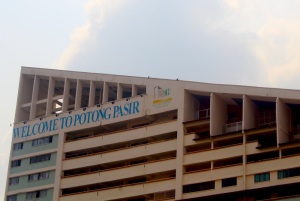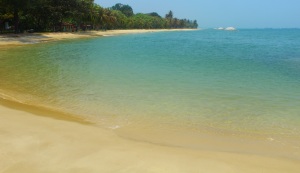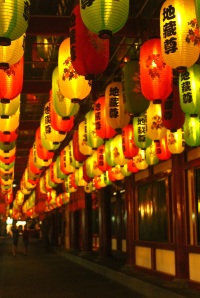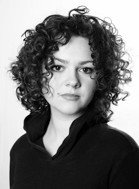Life: One Month On.
Posted: October 7, 2012 Filed under: Art, Books, Food, Life, Stage, Travel | Tags: arts, culture, expat, Singapore, travel Leave a commentOne month ago, the wheels of a Cathay Pacific plane touched ground at the Singapore Changi Airport. It was early afternoon and the sky was white and bright, like a blank canvas, full of expectations. As I walked out of the cabin and inhaled my first gulp of tropical air, a rush of emotions sped through my mind. Did I make the right decision by moving here? What happens if I don’t find a flat or a job by the time my hotel room and tourist visa expires? Goddamn it’s hot.
One month on, it’s still too early to tell where this adventure is going to take me, and I’m yet to find a proper job, but at least I’m starting to find my feet around this little red dot. I’ve settled into a nice little room that’s right beside the river, and I’ve just about cracked the code of bus numbers and untangled the colourful MRT lines.
Some of the rumours I’ve heard about Singapore are absolutely true. Chewing gum is illegal. As is graffiti. As is taking durians onto public transport. As is protesting. Drug use will get you spanked and imprisoned, and drug trafficking will cost you your life.
Sometimes it does feel a bit like a jungle of red tape here, especially when they ask for your passport number for everything, from booking theatre tickets to renting a Segway. Sometimes I feel like the government is stricter than my own mother (although to be fair, I am fortunate enough to have a very easy-going mum so perhaps I’ve just been spoilt).
And I guess I can see why some people call this place ‘Singabore’, amongst many other nicknames. In many ways the people here live extremely sheltered lives: the weather remains warm all year round; the food is cheap; the crime rate is low; the economy is relatively stable. But as I put on my explorer’s hat and start to discover the Real Singapore, I’m finding that there is much more going on here than people are initially led to believe.
Here are a bunch of things that I’ve managed to achieve in my first month here, and I look forward to digging even deeper into what this place has to offer. Enjoy!
1. Found a home.
As I mentioned in an earlier post, the road to finding a roof over our heads was unnecessarily long and twisted. Rent is extremely high in Singapore. As my boyfriend and I are living on a tight budget, we can thus only afford to rent a room. After an arduous search, however, our efforts paid off in the form of a nice big ensuite master room in a maisonette at the Potong Pasir HUDC (Housing and Urban Development Company, i.e. semi-public) estate. It’s not the most luxurious place, but it’s clean and safe and spacious – and most importantly, it’s home.
2. Sniffed out cheap shopping places.
Toa Payoh, one of the larger residential districts in Singapore, is only a 15-minute bus ride away and is home to one of my favourite stores for home appliances. Courts is essentially the local version of IKEA, selling everything from sofas to vacuum cleaners to wall deco to TVs. For cheap clothes and accessories I go to Bugis Street (which earned bonus points for having an awesome website). Yes it’s touristy and yes it’s always crowded, but if you don’t mind spending hours digging through piles and piles of fabrics in search of those one or two hidden gems, your efforts will usually be rewarded with a great bargain. As for toiletries and kitchen things, there are a couple of cosmetic shops at Chinatown’s People Park Complex (I especially like one called Ocean) which on average sell them at a lower price than the big supermarkets.
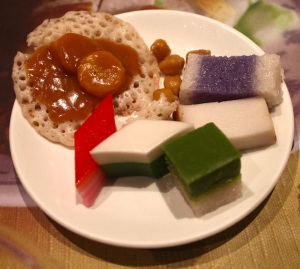
A plate of Singaporean desserts, none of which I can remember the name of… Photo by Gwen Pew, Sept 2012.
3. Experienced the midnight shopping phenomenon that is Mustafa.
As a city girl, I’m no stranger to late night shopping. In fact, the only thing that I never quite got used to in England is how early shops there close – 6pm and every single store is locked and shuttered. Are they mad? Singapore, on the other hand, has shown me the opposite end of the spectrum. Mustafa (no, not Simba’s dad, that’s Mufasa, though I still get them mixed up far more often than I would care to admit) is an Indian department store that is open 24 hours. We decided to go at midnight in order to beat the weekend crowd, but it was still close to pandemonium in there. Who knew that so many kids would be toy-shopping at that time of night? Still, there is no doubt about the greatness of the place in both size and variety. It stocks pretty much everything you can think of – clothes, electronics, beddings, kitchen utensils, groceries, every type of spice under the sun. And buying them at 1am just somehow makes everything that little bit more exciting.
4. Became acquainted with local food.
I was given a crash course on Singaporean hawker food when I first arrived, but I’ve barely scratched the surface. The cuisine, like their bewildering Singlish names, is a mixture of Chinese, Malay, Indian, Indonesian, Western and influenced by many others. Char kway teow, chai tow kuay, popiah, rojak, otak otak – you might as well just throw me a bunch of made-up sounds. Even the more English-sounding ones are confusing – what the hell is economy rice? And then there are the drinks, teh tarik, ee bee chui, bandung. Don’t get me started on desserts. To become well-versed in the local menu is to learn a new language, but as food sits right at the centre of Singaporean culture, it’s a compulsory life skill to acquire.
For those of you who are interested, here is a fun little video of a Hokkien song about a range of of Singaporean food. Don’t worry if you don’t understand a word – I don’t either – just marvel at the images and drool.
5. Checked out the arts scene.
This is still very much a work in progress for me, as I arrived with practically no previous knowledge of the arts scene here. There’s still a lot left to be explored, but so far I’ve been to the Singapore Art Museum and the Chan Hampe Gallery, as well as The Substation for my first taste of local theatre. Many outsiders think that the arts landscape here is ‘sterile’ and while I agree that it is still in its infancy stage, I am definitely seeing lots of sounds and colours with a distinctively Singaporean flavour bubbling beneath the surface. It’s a really exciting time to be in the country and I look forward to seeing much more of what it has to offer.
6. Started hunting out quirky places.
Again, I am far from being fluent in terms of knowing the coolest, quirkiest places in town, but I’ve made a start. So far the most amazing one that I’ve came across is BooksActually, an independent book and gift shop that opened in Tiong Bahru seven years ago. Since then they have established the Math Paper Press, which publishes the works of emerging local talents. I have ongoing plans to check out various districts and the hot hang-out spots associated with them – stay tuned!
7. Acquired sandal-shaped tan lines on my feet and sunburn on my shoulders.
A week of wearing the same patterned sandals on this mostly sunny island turned my feet into a two-toned painting of circles and lines. My mother bluntly described it as ‘ugly’ when she saw it, but I maintain that it’s artistic – if Miró gets away with it on a canvas, I should get away with it on my feet. Still, I made the effort to even them out by spending an entire afternoon sprawled across the sandy shores of East Coast Park beach doing absolutely nothing but listening to the waves. I got results and the tan lines vanished, but my shoulders suffered the consequences as they got severely burnt to the point where I couldn’t even have a strand of hair near them. You just can’t win with some things.
8. Acted as tour guide when my parents visited.
We had barely moved here for three weeks when my parents happily announced that they would be paying us a visit. As overjoyed as I was to see them, it’s hard to strike a balance in the itinerary-planning as my mum was perfectly happy to take things easy, while my dad made it loud and clear that he wanted to sightsee as much as he could. Plus they were only here for three days. (Certain people I know would insist that that’s all the time you need to see Singapore, but I beg to differ.) In the end we ended up going to Singapore’s newest tourist attraction, Gardens by the Bay, Orchard Road, Chinatown, Sentosa, a kopitiam (a smaller, indoor version of a hawker centre) and Swee Kee Chicken Rice. Everyone seems happy afterwards so I’m going to proclaim the whole shebang a success.
9. Partook in a local festival.
Last week the local community celebrated the 3,000-year-old tradition known as the Mid-Autumn Festival, which originated in China and is celebrated on the 15th day of the eighth month in the lunar calendar. Unfortunately I missed the Mass Lantern Walk in Chinatown, but still had plenty of fun with my paper lantern as I thronged through the crowds at the carnival, Buddhist temple and various light displays. Find out more about it on my last post.
10. Made it to Malaysia and back.
A more detailed post about my journey from Singapore to Johor Bahru will be coming shortly, but in short, it’s not as complicated as I had initially feared. It only takes about half an hour and a few bucks, and you’re there. Most expats go to JB in order to have their visas renewed, and luckily everything is fairly straightforward on that front.
The only problem I had was the fact that JB is a very depressing city. It has none of the ‘raffish charm’ that Tennessee Williams describes New Orleans as possessing in A Streetcar Named Desire, but instead just feels rundown and unloved. We initially planned on exploring the place seeing as we made it there anyway, but after a short wander we came to the conclusion that there really is nothing to do there. There is as much wasted potential as there is wasted retail space, as shopping malls are built but mostly remain empty and decrepit. The only place that one can properly wander round for an hour or so is City Square, apart from the Chinese and Hindu temples and Indian mosque, which are worth a quick glance.
To say that I was glad and relieved when we arrived back in Singapore is a big understatement. The country may be years away from becoming the next London or New York, but at least it’s definitely on the right track.

A list of ‘Place [sic] of Interest’ listed underneath a map at the Johor Bahru town centre. Who said Singapore’s boring? Photo by Gwen Pew, Sept 2012.
Catherine Bailey, West End Actress (LONDON, UK)
Posted: November 29, 2011 Filed under: Interviews, Stage | Tags: actress, arts, Bailey, Catherine, Criterion, interview, stage, The 39 Steps, theatre Leave a commentWhat is it like being the only actress in The 39 Steps?
The cast are a dream team and I totally lucked out in being cast alongside them; namely Andrew Alexander, Stephen Critchlow and Ian Hughes. I love performing with them, and the roles I play in the production are a total gift – it’s rare and such a treat to be able to play such varied and exciting women! As for being the only female – well this is not unusual – there are fewer parts for women in drama generally, but I think this is something people are changing, particularly in the case of older women. There is a campaign to make TV and film makers feature women more prominently actually, to redress the balance, sign up if you agree! http://www.gopetition.com/petition/24658/sign.html
Which – if any – of the three characters you play do you identify with most?
Well I’d love to think I had Pamela’s gumption, Margaret’s heroism and Annabella’s mystique, but in reality I don’t have much in common with them – apart from bearing a striking resemblance to them all of course.
How much creative license do you have as actors?
Rehearsing the play was a bit like learning a dance – there were ‘moves’ to learn. So we start with that and then flesh it out with our own embellishments and ideas, but whilst staying within that choreographed remit. It is quite disciplined, but it must be combined with mischief, playfulness and joy too.
Do you improvise or is everything scripted?
Everything is scripted even if it seems improvised thanks to Patrick Barlow’s script. He is a genius and I recommend you watch him in The National Theatre of Brent. You can see it online on 4OD: http://www.channel4.com/programmes/massive-landmarks-of-the-twentieth-century/episode-guide/series-1
What is the best thing about being in The 39 Steps?
I mentioned that element of ‘play’ which for me is at the heart of The 39 Steps – so that combined with getting a live audience reaction is the best thing I reckon!
What is the best moment you have experienced in your career?
I was a child actor so the one that stands out is one of my first acting jobs, which was when I was in Spring Awakening at the RSC (not the musical, the play adaptation by Ted Hughes). I had a total blast and made lifelong friends as well as running about backstage at the Barbican. For a 15 year old it was a rather dazzling experience!
How do you feel when you’re on stage in front of a live audience?
There is something great about telling a story to a room full of people, especially if they are listening and laughing. The reactions of the audience feed into what we’re doing on the stage. The trick is to relish the participation of the audience without getting self indulgent, so telling the story has to remain the most important thing.
Most awkward moment when you’re performing?
Recently there was a technical fault and so the lights didn’t come up for a scene at the start of Act 2. Us actors didn’t know whether to start the scene in the pitch dark or wait until some lights came on. We did the latter, which was fine, but there was a brief moment of blinking whilst retinas adjusted to the light! We got away with it, our technical crew are so professional and quick-witted I don’t think the audience even noticed!
What is your biggest dream?
To keep on working as much and for as long as possible!
Do you try and separate your work and your personal lives? Is it difficult?
I am lucky to have a terrific fiancé who supports me and understands how irregular the life of an actor can be, as well as great friends, many of whom are also actors, so I’m not short of people I can discuss the trials and tribulations of the profession with!
What is your message to any aspiring actors and actresses out there?
Get out there and do it! Join a drama club, or set up a play-reading group. Make your own work if necessary by setting up a theatre company – I did this with some friends a while ago and it is hard work but so rewarding and such a creative outlet – we are called Baz Productions and just put on our first show which went down a storm! I would add that my final bit of advice to aspiring actors is to be tenacious!!!
* ** *** ** *
Catherine will be performing at the Criterion Theatre until July 2012.
